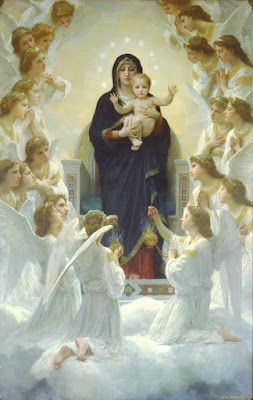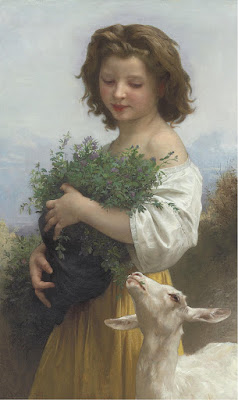This week I'm going to post two images per day of Bouguereau’s work--one piece that I don't like and one that I do.
Nationality: French
Born-Died: 1825-1905

The Virgin With Angels
Creation Date: 1900
Media: Oil on canvas
This painting is an example of artistic second-handedness that would rival the likes of Peter Keating.
When it came to depicting entities with realism, as volumetric and located within a deep space, Bouguereau’s abilities were extremely strong. So what happened in this painting? The angels that flank Mary and Jesus are not represented as standing within any kind of plausible space and instead they are stacked on top of one another. For these figures to be positioned in this way they would have to be cardboard-cutouts, not solid, volumetric bodies. The decision to paint these figures in this way was both an aesthetic error and a philosophical error, no different from the aesthetic and philosophical error reflected in cubist space.
By stacking the angels that flank Mary and Jesus in this way Bouguereau made a very strong and very specific statement by referencing the work of pre-Renaissance painters. He decided to forgo the realism he presumably worked hard to achieve and for what? Disappointingly, he did it to pay tribute to backwardness and regression.
During the medieval period, artists struggled to depict entities with realism. Many artists were even burned at the stake for deviating from the painting customs of the period. One of the most important breakthroughs in art and in the science of realistic representation came when the painter Giotto was able to depict a group of angels flanking Mary and Jesus (just like in this painting) with more realistic depth and volume. It is not exaggeration to say that this advancement marks the artistic start of the Renaissance.
Here is an example of the way Madonna and Child paintings with flanking angels were made prior to Giotto…

Maestà
Artist: Cimabue
Nationality: Italian
Born-Died: before 1251 - 1302
Creation Date: 1280-1285
Size: 151.6 in × 87.8 in (385 × 223 cm)
Media: Tempera on panel
Location: The Uffizi Gallery, Florence, Italy
…and here is Giotto’s painting, which presents the angels not as stacked, cardboard-cutouts, but as volumetric bodies that exist within space.

Madonna Enthroned or The Ognissanti Madonna
Artist: Giotto
Nationality: Italian
Born-Died: c. 1266/7 - 1337
Creation Date: c. 1310
Size: 128 × 80 in (325 cm × 204 cm)
Media: Tempera on panel
Location: The Uffizi Gallery, Florence, Italy
For Bouguereau to paint Jesus and Mary in the pre-Giotto manner is more than just bizarre, it is a statement about what Bouguereau really thought of his own aesthetic philosophy, what he really thought about the importance of art, of realism in art, of reason and of himself. This painting shows me that the aesthetic platform he usually worked from was something he did not hold with much certitude—he may have thought, “Realism is fine for painting pretty girls and happy children--unimportant, earthly things--but when it comes to painting serious things--when it comes to painting God--realism and reason should be abandoned in favor of ignorance and faith in ancient traditions.” Unfortunately, this painting also shows me that Bouguereau must not have had much pride in his own career if he was able to paint a major work that went against everything he previously stood for. This is a perfect example of selling out. I cannot know if Bouguereau’s other work was made from a position of sincerity or not, but this painting casts serious doubt on that idea.
Just as Peter Keating was willing to disregard the classical style to work in a modernist style, so too is Bouguereau willing to throw away the realism he struggled for in order to copy the style of medievalists.

Little Esmeralda
Media: Oil on canvas
To wash away the distaste of the previous painting, I suggest viewing this wonderful painting of Esmeralda and her goat, Djali, characters from Victor Hugo’s Hunchback of Notre Dame. I enjoy the gesture of the figures, the subtle tonalities and the interesting detail of the plants she is holding.
The muted colors of the sky work well to enhance the soft colors of the primary figures. Cleverly, some of the darker tonalities on Esmeralda’s face are saturated with color, such as the tonalities of the ear and the corners of her eyes. Using bright (not light), but dark colors in this way brings warmth to the figure without flattening them. Additionally, the subtle smile on Esmeralda’s face was a nice touch and the way she and the goat are looking at each other embodies the fondness they had for one another. The goat is also nibbling on the plants she is holding--a nice way to unify the figures by creating physical interaction between the characters.
If you look closely you can see the areas of the hair that have been altered from the initial sketch. I think Bouguereau often used a camera lucida to draw the figures, but often employed creativity with the hair.
Bouguereau is not known for employing vivacious brushwork, which is a shame because it is a credit he has definitely earned. This painting has areas of very energetic brushwork that have been carefully integrated into the structure of the entities depicted.

No comments:
Post a Comment